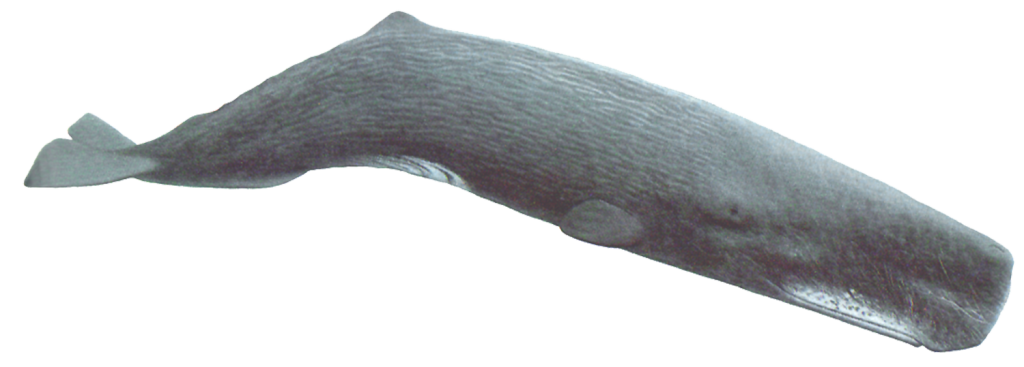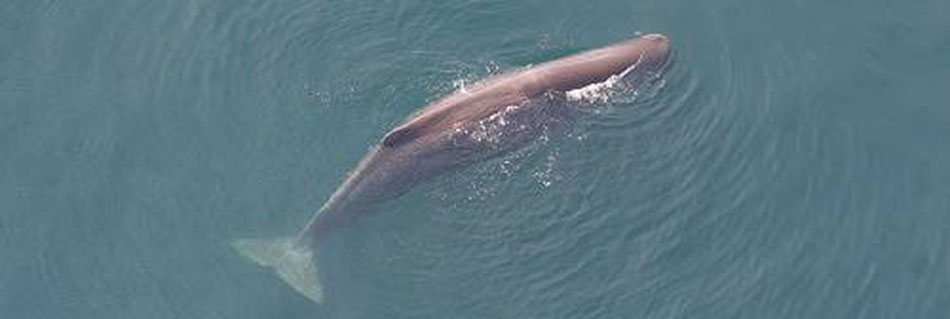SPERM WHALES
PHYSETERIDAE
Sperm whales represent an early cetacean success story that has remained almost unchanged for some 30 million years or about two million sperm whale generations. They may have been the first marine mammals to exploit the food supplies of the benthos, the cold, dark realm near the bottom of the ocean where creatures bizarre to us live, along with some more familiar ones. Except for the Ziphiidae or beaked whales, sperm whales are the only cetaceans that venture to these amazing depths, a mile (1.5 km) and more below the surface of the sea.
How the survive the enormous pressure of these dives, even how they catch their prey, remain mysteries despite our long acquaintance with these whales. They are so difficult to study in the depths of the sea that, in many respects, sperm whales might live on some other planet and be no less known than they now are. It is only when they rise to the surface, as they must do to breathe, that we see them and have the opportunity to study them at all.
We know that sperm whales produce intense, powerful, clicking sounds. We assume that they use these sounds to echo-locate their prey and to ascertain the topography of their environment. It may be that they also use them to communicate with one another, but if so they must have little to say since the clicks are monotonously repetitive. Listening to a herd of sperm whales is a little like listening to a score of carpenters nailing up a wall. (listen to the recording on the Sperm Whale web page).
No one knows precisely how a sperm whale produces its intense clicks. The late Dr. Kenneth S. Norris put forth the intriguing theory that the gigantic spermaceti organ (a complex mass of oil-filled connective tissue and sacs occupying most of the sperm whale’s forehead; the organ may be as much as 16 feet (5 meters) long and weigh 4,500 pounds (2,000 kilograms) acts as a resonating chamber for thunderous claps of sound produced by air exploding through a tight constriction in the right nasal passage. The sound is then emitted in pulses that correspond to reflections off the parabola-shaped skull region behind the spermaceti organ. As in an echo chamber, part of each reflection is re-reflected from the front end of the spermaceti organ by air-filled sacs that retain and recycle the blasts of air from the nasal passage instead of exhaling them. The sound bounces back and forth in the whale’s head producing diminishing replicas of the initial sound. This theory seems to agree with facts regarding the whale’s anatomy and the nature of the pulsed clicks. But no one has yet rigged up a sperm whale to test its intricate workings, and it is hardly likely that anyone ever will, at least with a healthy, free-living sperm whale — they are tremendously strong animals.
The sperm whale possesses the largest brain of any creature that has ever lived on earth, but no one knows what it does with so much neocortical tissue. As the long and successful reign of the dinosaurs has shown us, the brain need not be over-sized to control the motor functions of even a large animal; indeed, control of the motor functions seems to occupy only a small part of the whale’s brain, while the rest of it is highly developed, much as the human brain.
Theories and myths concerning its large brain often credit the sperm whale with the power of cognition and perhaps even extreme intelligence, but no one is sure how to find out what goes on in there. Some investigators suggest that the sperm whale’s brain creates a sort of acoustic hologram from the echos of all those clicks, and from the other sounds in the animal’s environment — that the sperm whale “pictures” with its ears as we do with our eyes. It would require great computational faculties to accomplish this feat, but, considering the sophisticated awareness of their surroundings that the sperm whale’s dolphin cousins seem to acquire through echo-location with their smaller brain, we cannot rule out the possibility.
Aggressive encounters between humans and sperm whales were frequent in centuries past, and often meant disaster for the land-based mammal. Whaling literature is replete with tales of ships stove in, whale boaters and whalers smashed to bits by furiously snapping jaws, the bits flailed to oblivion by power flukes that turned the water white. The hazards of small-boat encounters with sperm whales on the high seas still remain today.
In its evolution toward deep diving, the sperm whale has lost its adaptation for shallow water. Entire herds of sperm whales occasionally become disoriented close to shore and strand (click on the movie thumbnail left). This phenomenon is common among a number of species of cetaceans and is poorly understood. In some parts of the world, mass strandings of sperm whales have taken place repeatedly, leading to the theory that near-shore bottom topography in those areas may confuse the whales. Advocates of another theory contend that parasitical infestations of the whales’ ears may confuse their acoustical senses, leading to the strandings.
Among the sperm whales there are two diminutive forms known as the pygmy and dwarf sperm whales. Both animals resemble their giant namesake in many ways, including the possession of a spermaceti organ; but because they are not so numerous as the larger sperm whale, have virtually no commercial value, and are, therefore, not hunted, our knowledge of them comes primarily from examination of stranded specimens.









